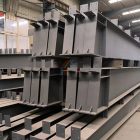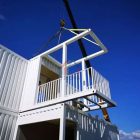Method for removing rust on steel structure surface
Generally, a lot of steel will be used in the construction of steel structure engineering. The function of steel itself has been specially treated, and generally will not show the phenomenon of rust. However, in the construction of steel structure engineering buildings, they can not be used up in a short time. And there are some special cases, such as acid rain corrosion, external force impact, pollutant accumulation, etc. It will lead to rust on the surface of the rigid structure, and then affect the normal use. Therefore, we need to take corresponding measures to deal with it at this time. So what are the methods of rust removal on the surface of steel structure?

1. Manual derusting method
Manual treatment mainly uses shovel blade, steel wire brush, abrasive cloth, broken steel saw blade and other things, and uses the methods of hand knocking, shovel, scraping, brushing and sand to eliminate the rust of steel structure. This is not only a traditional rust removal method, but also a relatively simple method, without any environmental and construction conditions. However, due to the poor efficiency and function, it can only be applied to a small range of derusting treatment.
2. Mechanical derusting method
Mechanical derusting method mainly uses some electric and pneumatic equipment to eradicate rust. Common electric equipment, such as electric brush and electric grinding wheel; Pneumatic equipment, such as a pneumatic brush. Electric brush and pneumatic brush use the rolling of special round steel wire brush to remove rust or oxide skin by impact and friction. In particular, it has a good effect on the surface rust of steel construction, but it is difficult to remove deep rust spots. The electric grinding wheel is actually a portable grinder, which can be moved freely in the hand. The application of high-speed rotation of grinding wheel to remove rust has a good effect, especially for deep rust spots. It has high working efficiency, good construction quality and convenient operation. It is an ideal derusting equipment. However, attention should be paid not to pierce the metal skin of the steel structure during operation.
3. Chemical derusting method
The chemical treatment method is actually pickling and derusting method, which uses the acid solution to have a chemical reaction with the metal oxide to generate salts and separate from the metal surface. The commonly used acidic solutions are sulfuric acid, hydrochloric acid, nitric acid and phosphoric acid. During the operation, the acid solution is applied to the rusty part of the metal steel structure, which is slowly removed by chemical reaction with the rust. After the rust on the steel construction is removed, wash it with clean water, neutralize it with weak alkali solution, and then wash it with clean water, wipe it dry and dry it to prevent it from rusting quickly.
4. Flame derusting method
Flame treatment method is to use gas welding gun to burn a small number of deep steel structure corrosion spots that are difficult to be removed manually, so that the high temperature can change the chemical composition of the oxide of rust and achieve the purpose of rust removal. When using this method, attention should be paid not to burn through the metal surface and avoid thermal deformation of the surface of large-area steel structure.

The above is the way to remove rust on the surface of steel structure. In fact, before construction, the staff should carry out anti-corrosion treatment on their materials. If the appearance of the rigid structure shows rust for some reasons, the above methods can be applied.
The use process and function of different methods of steel structure derusting are different, which requires us to choose suitable methods for derusting according to our own needs and practical situation. There is no need to remove the rust of the steel structural if there is not a particularly large potential safety hazard. Reprocessing after a period of time can effectively improve the service life of the structure and strengthen the firmness.












